Physical Address
304 North Cardinal St.
Dorchester Center, MA 02124
Physical Address
304 North Cardinal St.
Dorchester Center, MA 02124
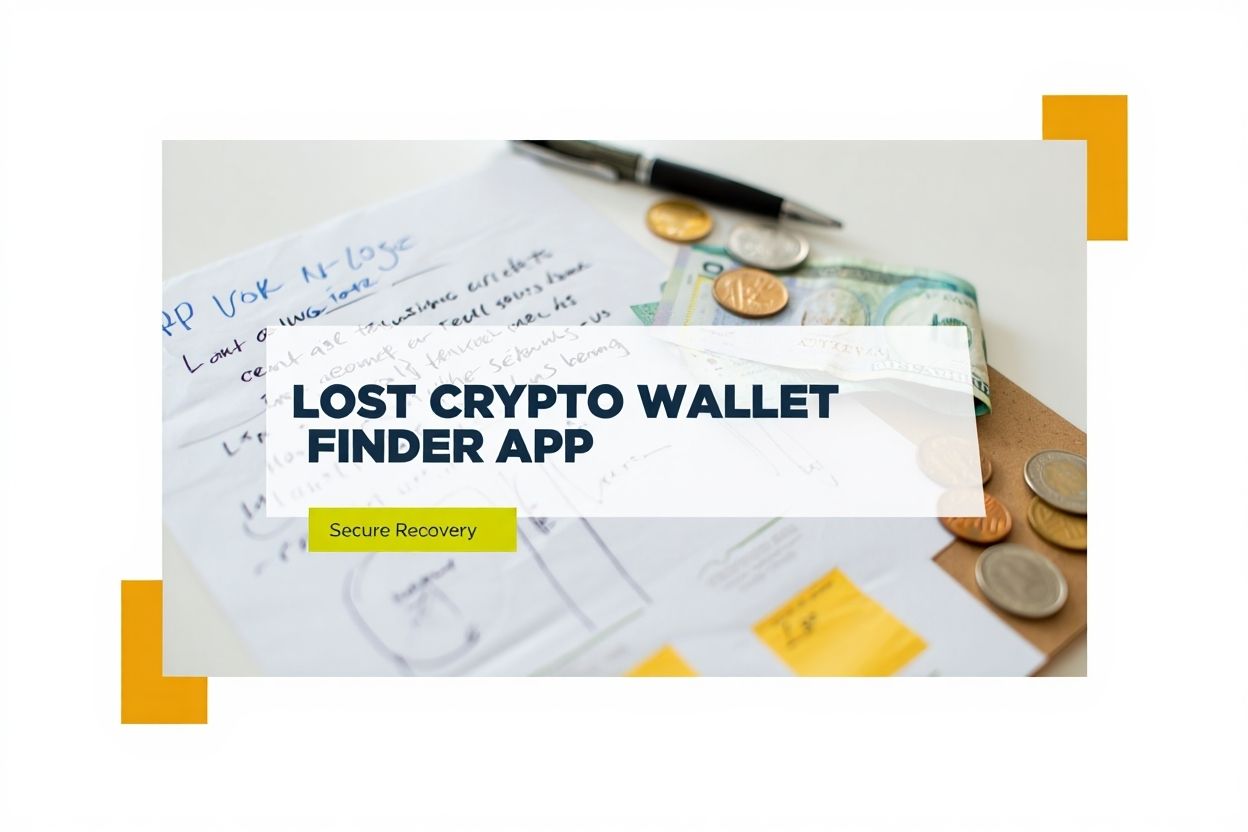
Losing access to your crypto wallet can feel paralyzing, whether it’s a life savings in Bitcoin or your first small investment. If you’re here because you’re facing this situation, know that you aren’t alone; millions of dollars in digital assets are lost every year due to wallet access issues.
Recent data from Chainalysis indicates that as of 2024, over 20% of all Bitcoin in existence may be inaccessible due to lost keys or forgotten credentials. High-profile losses and the stories of people retrieving (or losing for good) their wallets have been headline news from 2022 through today.
A lost crypto wallet finder app is designed to help you recover access to wallets that have become unreachable due to forgotten passwords, lost seed phrases, hardware failures, or accidental deletion. These tools and services use specialized methods to search for, unlock, or restore crypto wallets in various scenarios.
Security is critical in this space, many solutions exist, but not all are trustworthy. In this guide, you’ll find a transparent breakdown: what these apps are, how they work, common causes of wallet loss, and the safest steps to get your crypto back. Whether you’re a newcomer or experienced in crypto security, this guide is here to help you take the right next steps with confidence.
A lost crypto wallet finder app is a specialized digital tool or service designed to help users regain access to their cryptocurrency wallets when they’ve lost login credentials or wallet access. These apps utilize a variety of methods, scanning your device for wallet files, recovering forgotten passwords, brute-forcing seed phrases, or even using AI algorithms to increase recovery chances.

Generally, these solutions fall into several categories:
| Type | Description | Examples |
|---|---|---|
| General-purpose tools | Work with multiple wallet brands and file types | KeychainX, LostWallet (open source) |
| Wallet-specific apps | Designed for particular wallets (e.g., Ledger, Exodus) | Ledger Live recovery features |
| DIY solutions | Downloadable recovery scripts; require tech know-how | GitHub tools |
| Professional services | Experts handle the process with confidentiality agreements | Crypto Asset Recovery, Zengo support |
These distinctions matter because each scenario, and each wallet type, may require a different approach. Understanding the right tool for your situation is key, and we’ll cover use cases and actionable steps ahead.
Understanding why crypto wallets are lost helps users prevent mistakes and prepare for recovery. The causes often involve a mix of human error, technical failure, and inadequate backup practices.
Forgotten passwords or private keys: Many users create strong, complex passwords or generate private keys to secure their wallets. Unfortunately, they often forget or misplace these credentials, leaving them unable to access their funds without recovery tools.
Lost or poorly stored seed phrases: Wallets typically provide a seed phrase—a set of words critical for recovery. If this phrase is lost, improperly recorded, or stored insecurely, the user may permanently lose access to their wallet, regardless of password strength.
Hardware wallet loss, damage, or malfunction: Devices like Ledger or Trezor are secure but fragile. If they are lost, stolen, or physically damaged—and no backup exists—the coins stored inside may be unrecoverable, as the hardware is the only access point.
Deleted or corrupted wallet files: Mistakenly deleting a wallet file or suffering data corruption from software crashes or hardware failure can lock users out. Without a backup of the wallet file or seed phrase, recovery becomes extremely difficult.
Device loss or theft: Laptops, smartphones, and USB drives that store wallet files or apps can be stolen or lost. For non-cloud-based wallets, losing the only device with wallet access means losing the wallet itself unless a backup is available elsewhere.
Inheritance or access control issues: If the wallet owner passes away without sharing recovery instructions, families or executors often struggle to regain access. Without proper inheritance planning, crypto assets can remain locked forever.
User mistakes and scams: Accidental exposure of private information through phishing attacks, scam apps, or poor storage practices frequently leads to wallet loss. Social engineering remains one of the top threats to wallet security.
According to a 2023 Wallet Recovery survey, nearly 40% of lost crypto cases result from forgotten credentials, and 25% come from mishandling backup information. Real-world cases like Stefan Thomas losing 7,002 BTC demonstrate how even experienced users can make irreversible mistakes, highlighting the need for prevention and practical recovery solutions.
Lost crypto wallet finder apps in 2025 combine advanced technology with user input to maximize your chances of recovery, while keeping your data safe. Here’s a typical step-by-step flow:
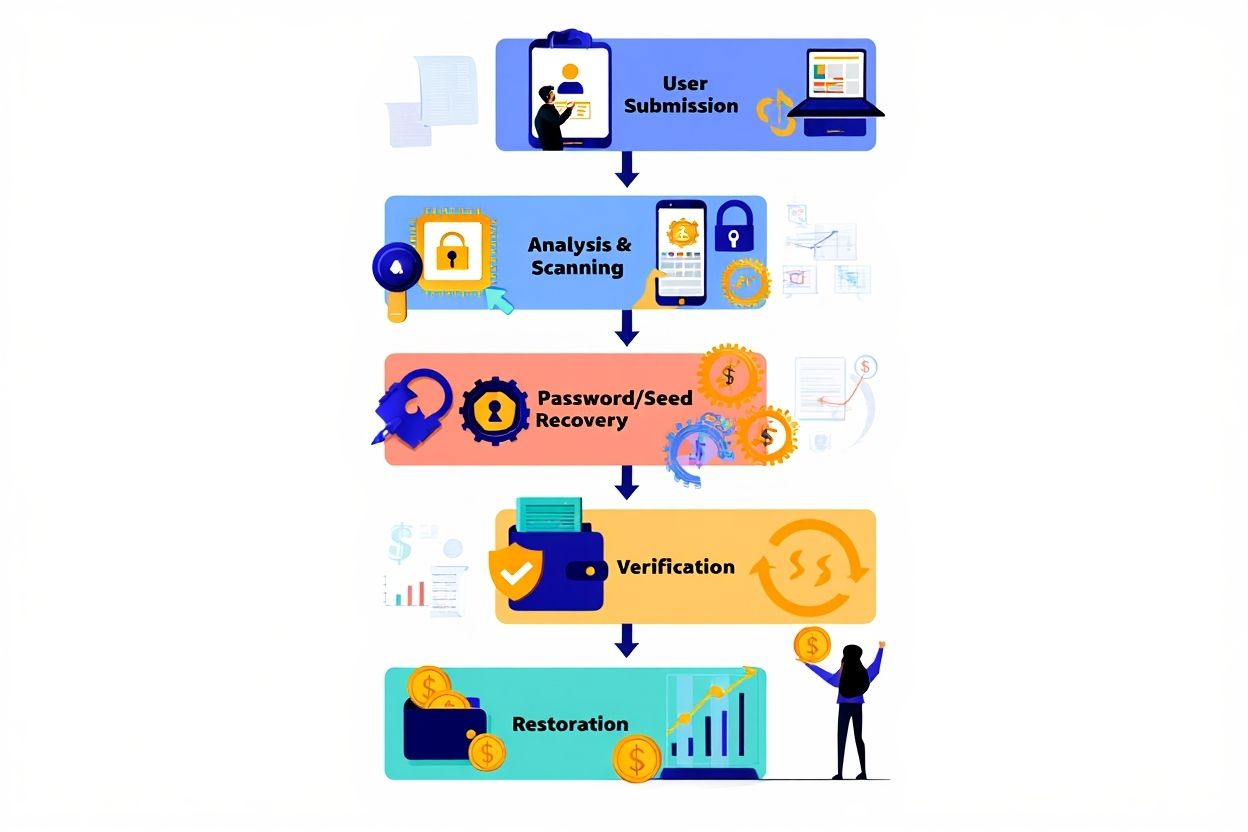
Leading providers like KeychainX utilize encryption and never demand full wallet control, ensuring privacy and safety. Reputable apps are transparent about their process, security standards, and privacy policies, always prioritize services with clear track records and positive user experiences.
Check out our related articles for more information about stuffs like these:
Choosing the right wallet finder app or service is essential to recovering your lost crypto safely. In 2025, several trusted providers offer advanced recovery tools with proven results and strong reputations in the crypto security space.
| App/Service | Wallet Types Supported | Features | Trust & Credibility | Pricing | Reviews/Summary |
|---|---|---|---|---|---|
| KeychainX | Bitcoin, Ethereum, most major wallets | AI password recovery, hardware/software support | 2017+, strong track record, BBB rated, audited | Success-based fee (15-20%) | “Recovered my Ledger after I lost both device and backups.” |
| Zengo Recovery | Zengo, mobile wallets | Seedless recovery, biometrics, multi-chain | Established, crypto insured, official support | Free up to a threshold, then fee | Very user-friendly, easy for beginners. |
| LostWallet (Open Source) | Software wallets/HD wallets | Free, self-hosted, customizable | Peer-reviewed on GitHub; use at own risk | Free | “Powerful but requires technical skill.” |
| Crypto Asset Recovery | BTC, ETH, altcoins, software & hardware | Expert-led, legal agreements, high success rate | Media featured, 5+ years, verifiable team | No recovery, no fee | Trusted, clear communication throughout. |
| Ledger Live Integrated | Ledger wallets | Device recovery, backup sync, PIN reset | Official provider, security audits | Depends on solution | Highly secure, tightly integrated. |
Always check official sites for updates. Positive user testimonials and independent audits are green flags. Remember: avoid any “guaranteed” recovery service claiming instant results, if it sounds too good to be true, it probably is.
When you realize that you’ve lost access to your crypto wallet, your first actions are critical. Acting calmly and methodically can prevent further mistakes and improve your chances of recovering your funds.
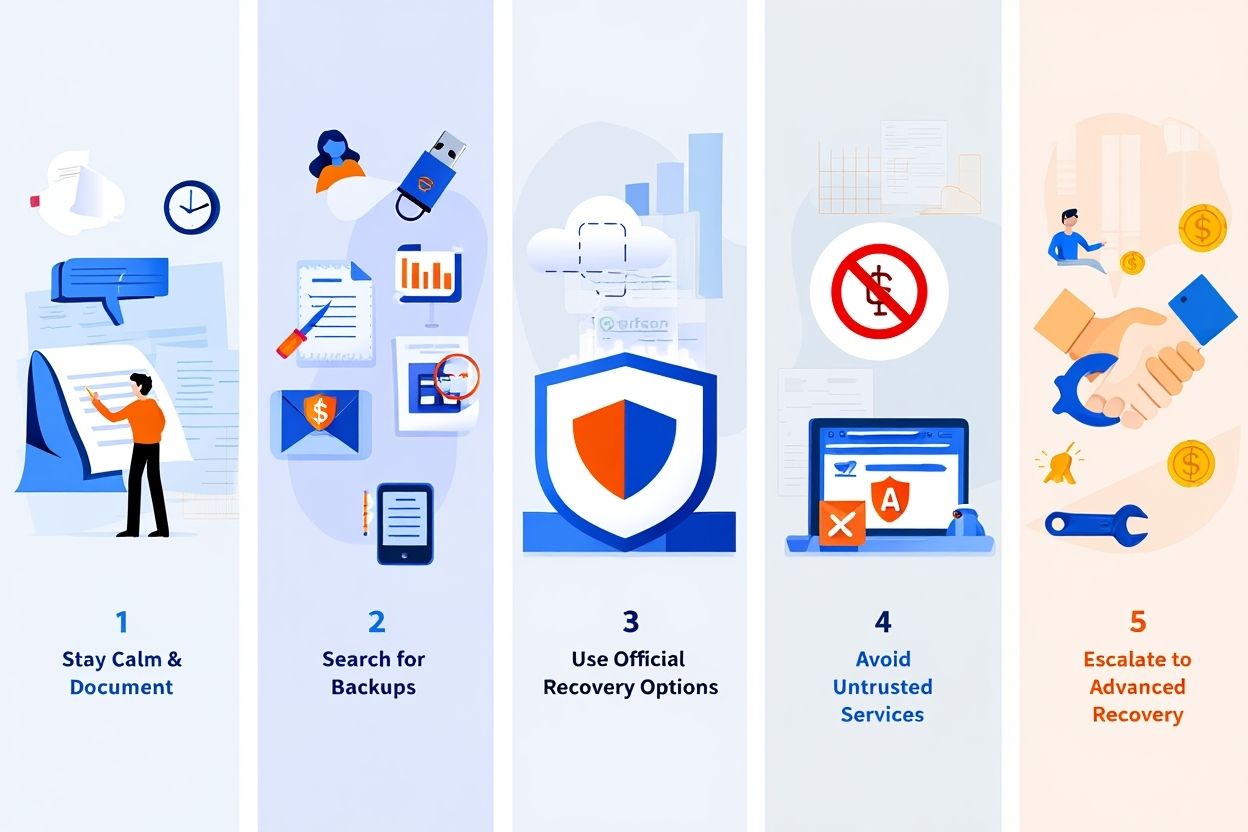
Stay calm and document every detail: Take a few minutes to note down when you last accessed your wallet, what type of wallet it was, possible passwords, and where your backups might be. Stress can lead to costly errors, so take a moment to think clearly before acting.
Search for backups in all possible locations: Look through password managers, cloud backups, USB drives, external hard drives, and paper notes where your seed phrase or private key might be stored. Don’t overlook old devices or forgotten accounts where backups could be saved.
Use official wallet recovery options first: Visit your wallet provider’s official website or help center. Many wallets offer built-in recovery tools like password reset options, seed phrase recovery processes, and device syncing features to help restore access.
Avoid untrusted recovery services: Never enter your seed phrase, password, or private key into unfamiliar websites or random recovery apps. Always verify URLs and double-check that support emails are genuinely from the wallet provider to avoid phishing scams.
Escalate to advanced recovery if needed: If official recovery options don’t work, evaluate whether to try a DIY recovery tool or hire a professional wallet recovery service. This step depends on your technical skills, confidence, and the value of your crypto.
By following these immediate steps, you increase your chances of restoring access to your crypto wallet quickly while protecting yourself from scams and irreversible mistakes.
When you lose access to your crypto wallet, following a clear step-by-step recovery process can save time and reduce mistakes. Each recovery scenario has its own approach, depending on the type of wallet and how it was lost.
Recovering a wallet with a seed phrase is one of the most straightforward methods, provided you still have your original recovery words.
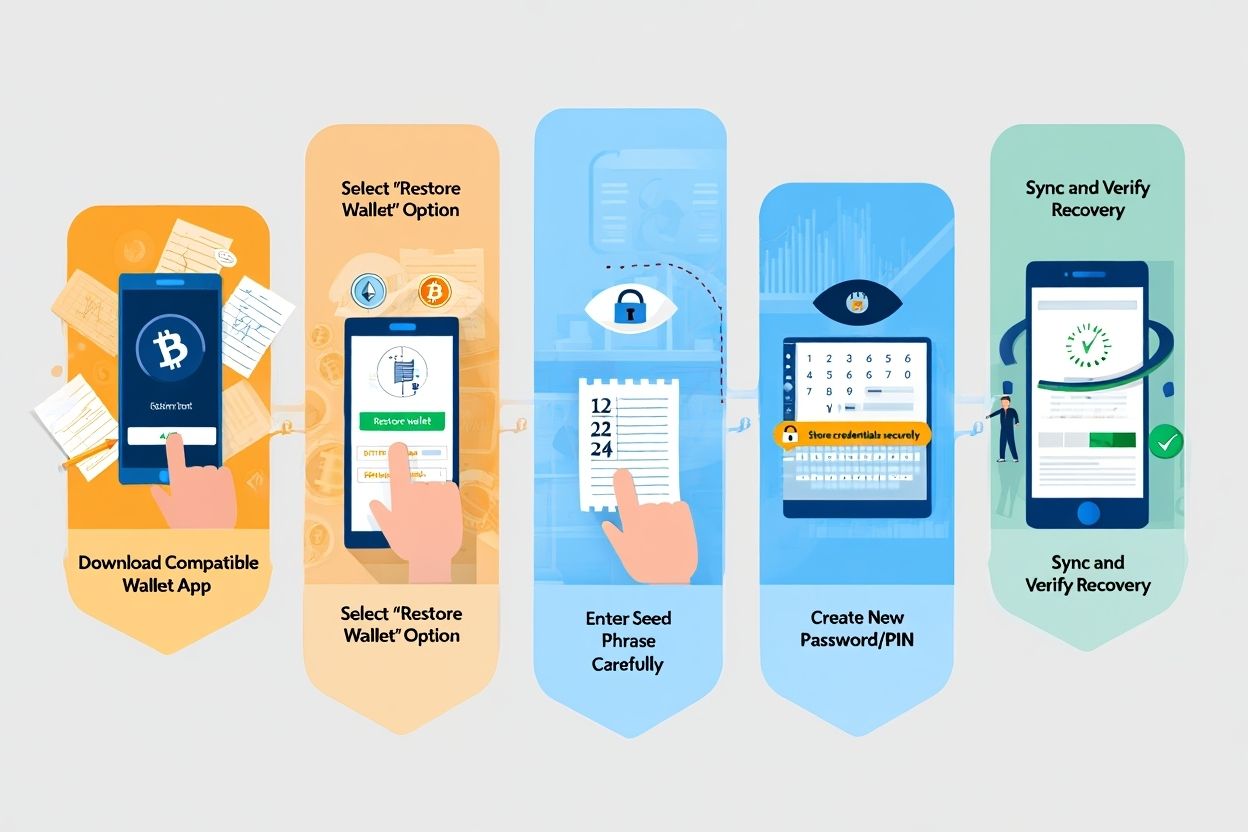
Download the same wallet app you previously used or choose a compatible wallet that supports your crypto asset and recovery method.
Select the “Restore wallet” option in the app and carefully enter your seed phrase words in the correct order as they were originally given.
Create a new password or PIN to protect your wallet going forward, ensuring that your new credentials are stored securely.
Allow the app to sync with the blockchain; if your wallet address and coins appear correctly, your recovery was successful.
This method is simple but depends entirely on having your full, correct seed phrase.
Lost passwords and private keys present a bigger challenge, but modern tools offer helpful solutions.
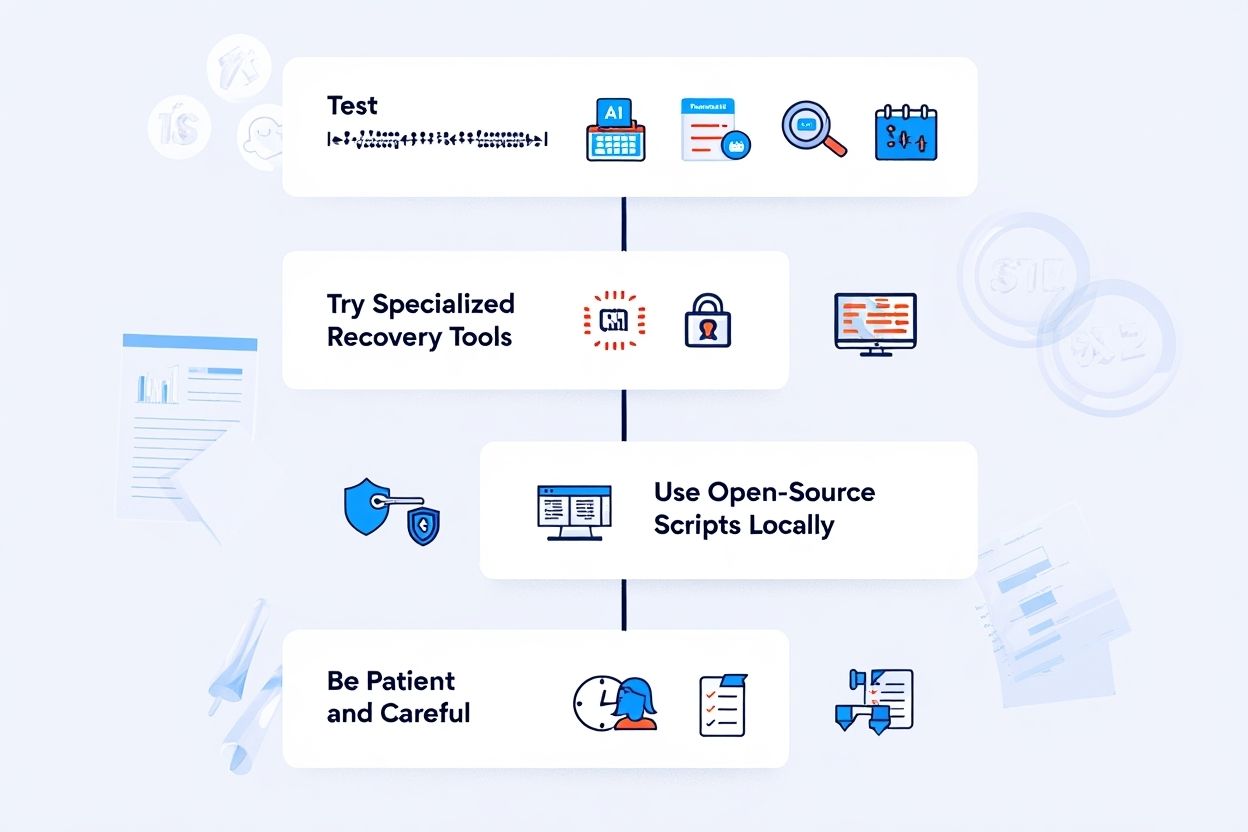
Test all possible password variations you might have used, including common phrases, date formats, or typical spelling changes.
Consider using specialized tools like KeychainX, which apply AI algorithms to recover crypto wallet passwords without exposing your data online.
If you are technically skilled, use open-source scripts to run password lists locally on your machine, ensuring you never upload your private keys to the internet.
For password recovery, patience and careful testing improve your chances of success.
Hardware failures and accidental deletions require a combination of physical access and data recovery tools.
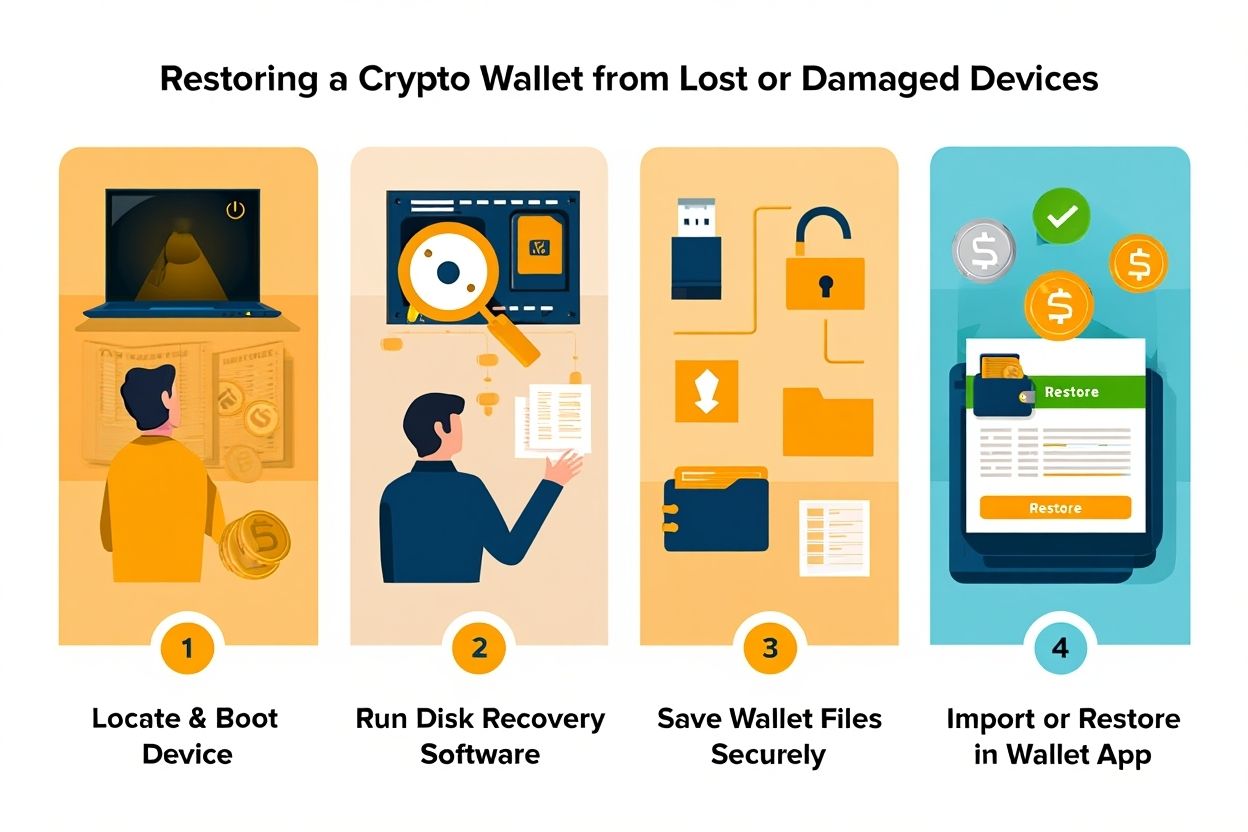
Locate and boot the lost or damaged device if it’s physically available and still operational.
Run disk recovery software to scan for deleted wallet files or corrupted data fragments related to your crypto wallets.
Save any found wallet files to a secure, encrypted backup location for later restoration.
Use your crypto wallet app’s “Import” or “Restore” function to load the recovered wallet file and regain access to your funds.
Device-based recovery works best when the storage media hasn’t been physically damaged beyond repair.
If your hardware wallet is lost or no longer works, the recovery process depends heavily on whether you backed up the seed phrase.
If you have the seed phrase, purchase a new compatible device and select the “Recover from seed” option during the setup process.
If no backup is available, contact the wallet manufacturer’s support team. In some cases, professional data recovery services can attempt to extract the wallet data from the damaged hardware chip, but this process is expensive and not always successful.
For hardware wallets, having a backup is often the difference between full recovery and permanent loss.
If self-recovery methods fail, reputable wallet recovery services can help in a secure and confidential manner.
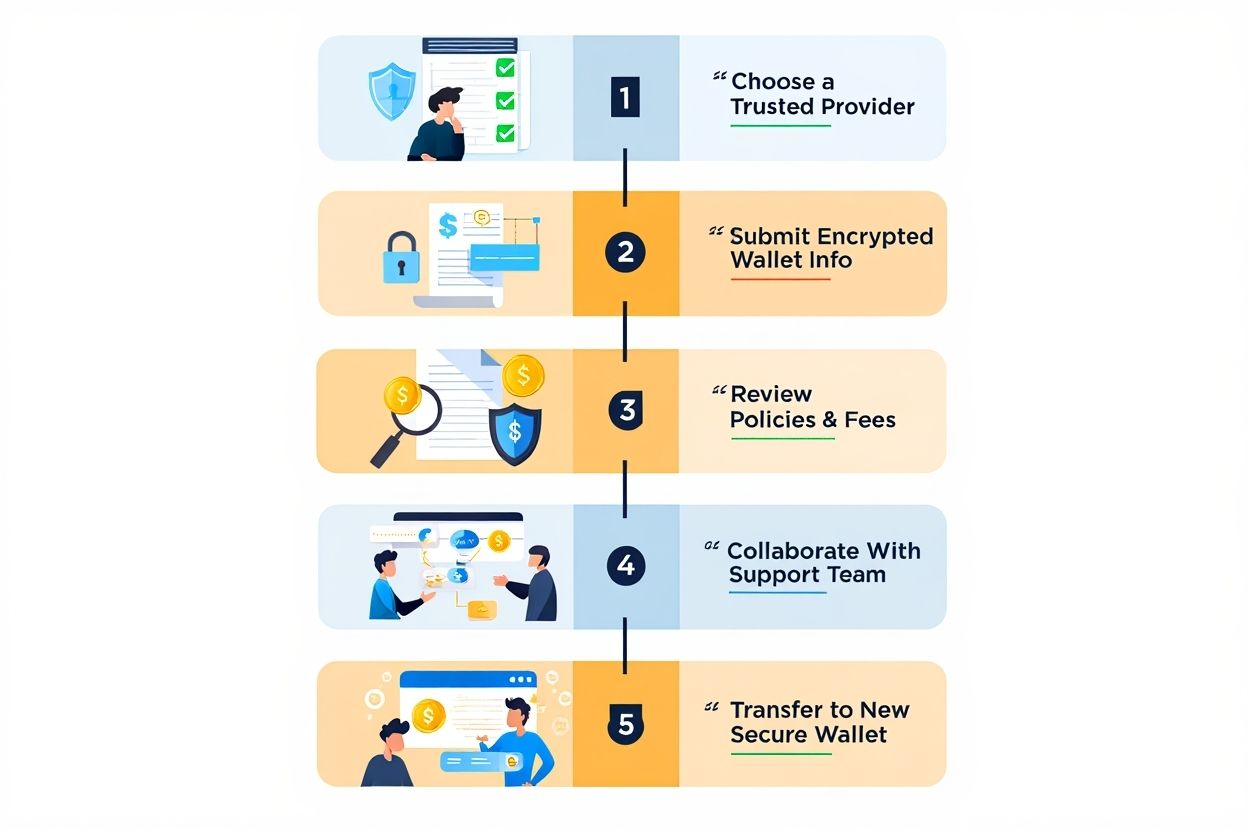
Choose a trusted wallet recovery app or service from verified providers (see the recommendations above for vetted names).
Submit an encrypted version of your wallet file or partial login credentials to initiate the recovery process, never sharing your full seed phrase.
Carefully review the provider’s privacy policies and fee structures, and avoid services that request full control over your wallet.
Collaborate with their technical support team through the recovery steps, providing any additional information they may request securely.
Once recovery succeeds, immediately transfer your crypto to a new, secure wallet with fresh backups to prevent future losses.
Following these steps minimizes your risk while maximizing your chances of successful wallet recovery.
Before you begin any recovery process, remember this critical warning:
Never trust random direct messages offering crypto recovery services on platforms like Telegram or social media.
These scams are common and often result in permanent asset loss. Stick with well-known, verified platforms and recovery companies.
Not all wallet recovery apps and services are created equal. Here’s what to look for to ensure you’re not falling into a scam:
Red Flags to Avoid:
If you suspect a scam, check community forums or official wallet support before proceeding. Remember: in crypto, trust and verification matter at every turn.
View more:
When facing wallet recovery challenges, one of the most important decisions is whether to try fixing the issue yourself or to hire a professional service. Each approach has its pros and cons, depending on the situation and your technical confidence.
| Scenario | DIY Feasible? | Professional Needed? | Notes |
|---|---|---|---|
| Forgotten wallet password | Yes, with tools or scripts | If DIY fails | Try common guesses, then escalate |
| Lost seed phrase | No | Yes | Pros may attempt mnemonic recovery if partial |
| Device destroyed & no backups | No | Yes | Specialized hardware/data services required |
| Phishing loss | No | Possibly | Funds often unrecoverable, but try official support |
DIY recovery is generally cheaper and faster for simple problems like forgotten passwords. However, it comes with higher risks, especially if you lack technical knowledge or experience. Using safe, well-reviewed recovery tools is essential to avoid worsening the situation.
Professional services, on the other hand, are better suited for high-value wallets or complex cases. They bring specialized tools, legal protections, and years of crypto recovery expertise. In most cases where the risk of irreversible loss is high such as hardware damage or missing seed phrases—choosing a vetted professional is the safest choice.
Ultimately, the right path depends on your confidence, the value of your crypto, and the complexity of your recovery challenge. Take time to assess your situation before making a decision that could affect your assets permanently.
Safeguarding your crypto wallet requires proactive measures that address both digital and physical risks. By implementing the following practices, you can significantly reduce the chance of losing access to your funds.
Whether you’re holding Ethereum, Bitcoin ordinals, NFTs, or DeFi tokens, these proactive habits balance convenience, security, and future protection, so your assets stay accessible for years to come.
A: Sometimes, using disk recovery tools before data is overwritten.
A: No. Total loss of seed and no backup usually means permanent loss.
A: Yes. Hardware, software, custodial wallets have different paths.
A: Bitcoin, Ethereum, and major altcoins, complex tokens need specialists.
A: Hours to weeks, depending on complexity.
A: Usually 10–25%, paid only upon success.
A: Wallet finder apps serve self-custodied wallets. Exchanges use KYC for account recovery.
Losing access to your crypto wallet can be stressful, but a trusted lost crypto wallet finder app may offer the solution you need. With the right tools and awareness, you can boost your recovery chances and avoid scams. By understanding common causes, immediate steps, and vetting recovery apps carefully, you improve your odds of getting your assets back safely.
Key takeaways:
Wallets are often lost to human error, scams, or poor backups.
Finder apps use AI, scanning, and secure methods to assist recovery.
Prevention, backups, drills, password hygiene, is your best defense.
Make prevention a priority by following best practices, and remember: in the decentralized world, security rests in your hands. For every challenge, there’s a solution, draw on expert advice, community support, and proven technology as you navigate your recovery journey.
Web Tai Chinh is your trusted resource for timely, accurate updates and insights on finance, giving you the clarity you need before investing and demystifying financial terms and concepts. Explore more wallet protection guides and crypto security tips in our Cryptocurrency category and start protecting your crypto today.
📞 Contact: 055 937 9204
✉️ Email: webtaichinhvnvn@gmail.com
📍 Address: 13 Ho Tung Mau, An Binh, Di An, Binh Duong